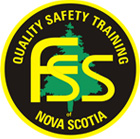Loading and Hauling With Self Loader
Hazards Identified
Spilled loads, personal injuries to operator, damages to other vehicles
Hazard-Specific Personal Protective Equipment
CSA approved Grade I foot protection, CSA approved hard hat, safety eye glasses, and reflective vest. Hearing protection will be required unless the equipment has a valid certificate indicating that noise levels do not exceed 85 dB.
Hazard-Specific Training
Safe Work Practice
Safety Standards
- Safety standards
- Class I license
- Vehicle inspection report and in place log book
- Loader certified annually by a competent person
- First aid & WHMIS trained
- Spill kit
- Remote location
- Plan first aid kit and two 3lb extinguishers
- Audible back-up alarm
General Requirements
- Never work under or near a power line
- Never be on top of the load or above 3 m of height unless fall restraint is in use
- Always use 3 point landings
- Ensure all mechanical equipment is inspected properly
- Mud flaps and slide guards in place
- Look for any obstruction(s) that may impede the arc of swing. Should there be any nearby impediment, pull the material at a low angle across the truck/trailer bed. Reposition the grapple beyond the balance point and lift over the stake(s) with caution.
- Loaders without heels will place the material that is being grappled on the opposite side of the boom from which the loader operator is situated.
- When using a heel, butts are to be placed under and in contact with the heel at all times.
- Assure that the load is crowned, contained within the truck or trailer stakes and the material is carefully placed and aligned so that each piece is in contact and mutually supported by the other(s).
- Random-length, ten or eight foot material on the back bay or truck bed will be placed so that the wood is sloped slightly toward the front.
Regulations, Standards and References
